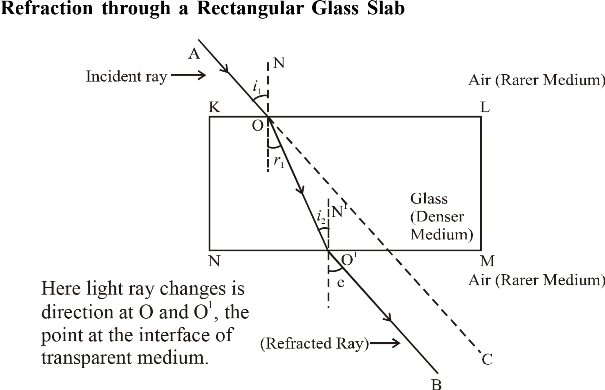
When a incident ray of light AO passes from a rarer medium (air) to a denser medium (glass) at point. O on interface KL, it will bends towards the normal. At point O1, on interface NM the light ray entered from denser medium (glass) to rarer medium (air) here the light ray will bend away from normal OO1is a refracted ray OB is an emergent ray. If the incident ray is extended to C, we will observe that emergent ray O1B is parallel to incident ray. The ray will slightly displaced laterally after refraction.
Note : When a ray of light is incident normally to the interface of two media it will go straight, without any deviation.
Laws of refraction of light
1. The incident ray, the refracted ray and the normal to the interface of two transparent media at the point of incidence, all lie in the same plane.
2. The ratio of sine of angle of incidence to the sine of angle of refraction is a constant i.e.

for given colour and pair of media, this law is also known as Snells Law
Constant n is the refractive index for a given pair of medium. It is the refractive index of the second medium with respect to first medium.

Refractive Index
The refractive index of glass with respect to air is given by ratio of speed of light in air to the speed of light in glass.

C → Speed of light in vacuum = 3•108 m/s speed of light in air is marginally less, compared to that in vacuum.
Refractive index of air with respect to glass is given by

The absolute refractive index of a medium is simply called refractive index

Refractive index of water (nw) = 1.33
Refractive index of glass (ng) = 1.52
Latest Govt Job & Exam Updates: